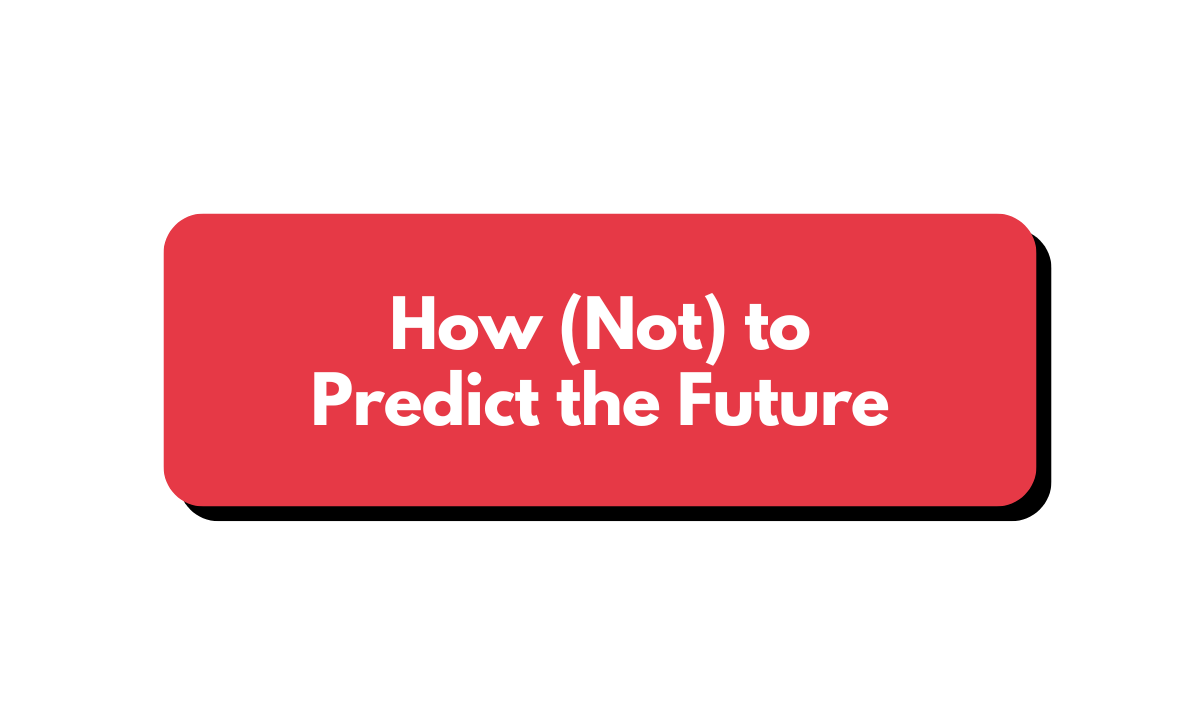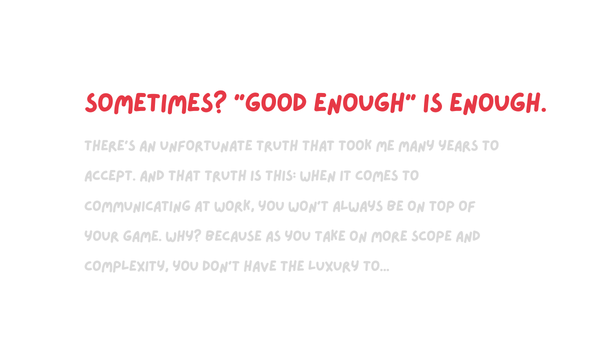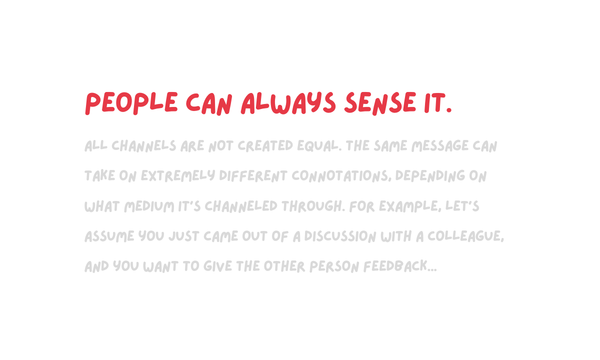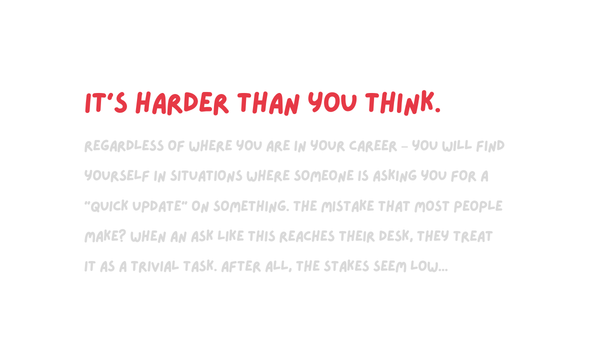How (not) to predict the future

One of the hardest things to do at work is to predict the future. Yet somehow we're expected to do this all the time.
For instance, we get asked questions like:
- How much user growth will this marketing campaign drive?
- How much share might we gain if we launch this feature?
- How big will the addressable market for X get in 5 years?
These are all fair questions – and sometimes they're relatively straightforward. You're in luck if you have enough historical data to extrapolate from.
But what happens when you don't have enough datapoints?
What if you're expected to forecast something that is, well, extremely hard to forecast?
That's when people tend to make one of two mistakes:
❌ Mistake A: Compensate for the lack of evidence with bravado or showmanship. After all, you know other people don't have a better answer. So you simply double down on your answer to push it through.
❌ Mistake B: Opt for the other extreme and refuse to take a stand on anything controversial. Caveat everything heavily, and use only the most conservative assumptions to avoid being challenged.
The right way to approach this? It's definitely not splitting the difference.
It's to stop chasing the perfect answer.
And to focus on the function instead.
What is "the function?"
Let's be clear about one thing first: No one has a crystal ball at work.
(Some people are good at making you think that they do. But really, they don't.)
Therefore, if you approach these forward-looking exercises by trying to land the "perfect answer?" You'll struggle. Because it doesn't exist.
Instead, you need to realize that any analysis is made up of three components:
- Inputs
- The Function
- Outputs
Inputs are your assumptions. Good assumptions are grounded in solid evidence. Weak assumptions contain a bit more subjectivity. But they're inputs all the same.
The Function is the crux of your analysis. It is how you extrapolate the unknown from the known. It is the model that turns inputs into outputs.
Outputs are self-explanatory. But if you fixate on it too much – it will trip you up.
Because here's the thing: Your goal isn't to simply convince your audience of your outputs ("I believe the market will grow by x% CAGR in the next 5 years").
Instead, your primary goal should be to convince them of your function ("I believe market growth will be heavily shaped by these 3 indicators").
Then the rest will naturally follow.
👋 Subscribe for free to get Herng's newsletter directly in your inbox.
Why should I focus on "the function?"
Here's why the function should be your primary focus – not your outputs.
If you focus only on defending your outputs, you can't handle objections contructively.
Someone will always feel that your answer is too high or too low. It doesn't matter whether their reactions are rational. You'll find yourself engaging in useless debate.
Instead, you want to go further upstream, and figure out if people are challenging your function – OR your inputs.
If they're challenging your function? You have every right to defend it vehemently. You can explain the logic behind your model. You can also incorporate feedback and sharpen your model accordingly.
It'll be a constructive discussion, no matter what. After all, all models are wrong, but some are useful.
What if they're challenging your inputs? That's fine too. In fact, assuming they are bought into your function – invite them to plug in their own inputs. Discuss why one input is more logical than another.
Because here's the thing: inputs will always take on some degree of subjectivity. And you can't control that about other people. Nor do you need to.
Instead, your should focus on building the most robust function possible. Then it's just a matter of figuring out the right inputs to feed it. And figuring out the corresponding rationale.
This allows you to decouple the inputs from the function. The former is much more subjective; the latter should be less so.
And when you do this well: you can then stand firmly behind your function, while still allowing the inputs to be up for (healthy) debate.
How to apply this framework
There's a couple things we can do to keep this framework top of mind.
The first is to always build scenarios.
Remember: no one expects you to be an oracle. You don't have to come up with one perfect answer.
(And if you do – it's likely false precision anyway.)
Instead: when you build scenarios, you get to experiment with different inputs. And you should then articulate what each of those scenarios implies.
For instance, we can do something like:
- Bear Case: Use 1% growth as the input (= the worst growth we've seen recently)
- Base Case: Use 3.5% growth as the input (= average growth rate this year)
- Bull Case: Use 5% growth as the input (= the best growth we've seen recently)
A common mistake here is to simply pick a base case, and then add or subtract nice-looking round numbers to give the semblance of scenario-building.
But this is not actually scenario-building. There's no logical rationale behind the inputs. There's no intention.
This brings us to our second point, which is to practice the discipline of asking ourselves:
"What Would You Have To Believe?"
"WWYHTB" is a great mantra, because it forces us to articulate the logic behind our assumptions.
In other words, you're allowed to use any input you want – as long as you can describe the "truths" it implies.
(And that's often the most valuable part of your thinking.)
For instance, compare the difference between...
- ❌ "I've assumed that GDP for market X will grow at 2% for the next 5 years" (Hard to contextualize, and hard to challenge productively)
...and the following:
- ✔️ "I've assumed that GDP for market X will grow in line with the average of our benchmark markets, which is around 2%" (Logical, and can be challenged in a productive way)
The other benefit of using the WWYHTB mental model? It helps uplevel your thinking, thereby improving the quality of ensuing discussions.
Because you're not simply trying to sell people on a given outcome ("I strongly believe the market will grow to $3Bn by 2030").
Instead, you're arguing over the conditions that need to be true for that outcome to occur ("I have evidence that suggests these 3 things will hold true – which then implies the market will become this big").
And that's a much more insightful discussion for everyone.
Key Takeaways
- No one has a crystal ball. You don't need to predict the future perfectly.
- Instead of getting the perfect output, focus first on getting a solid function.
- Inputs are important but can be subjective. And that's OK.
- Two things can help sharpen inputs: (1) Scenario-building (2) WWYHTB.


